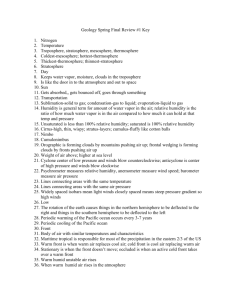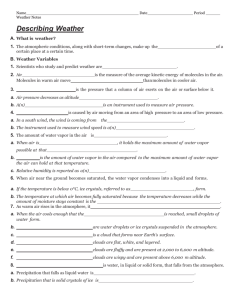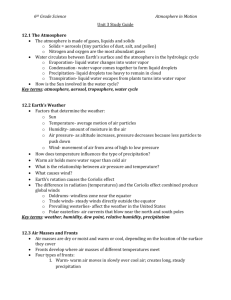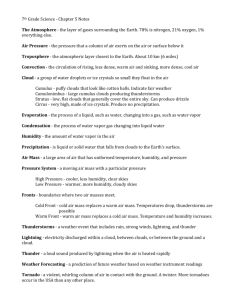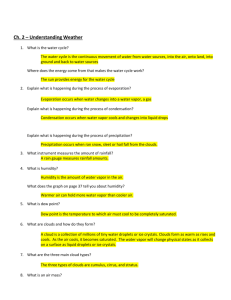Meteorology Unit SG1 Name
advertisement
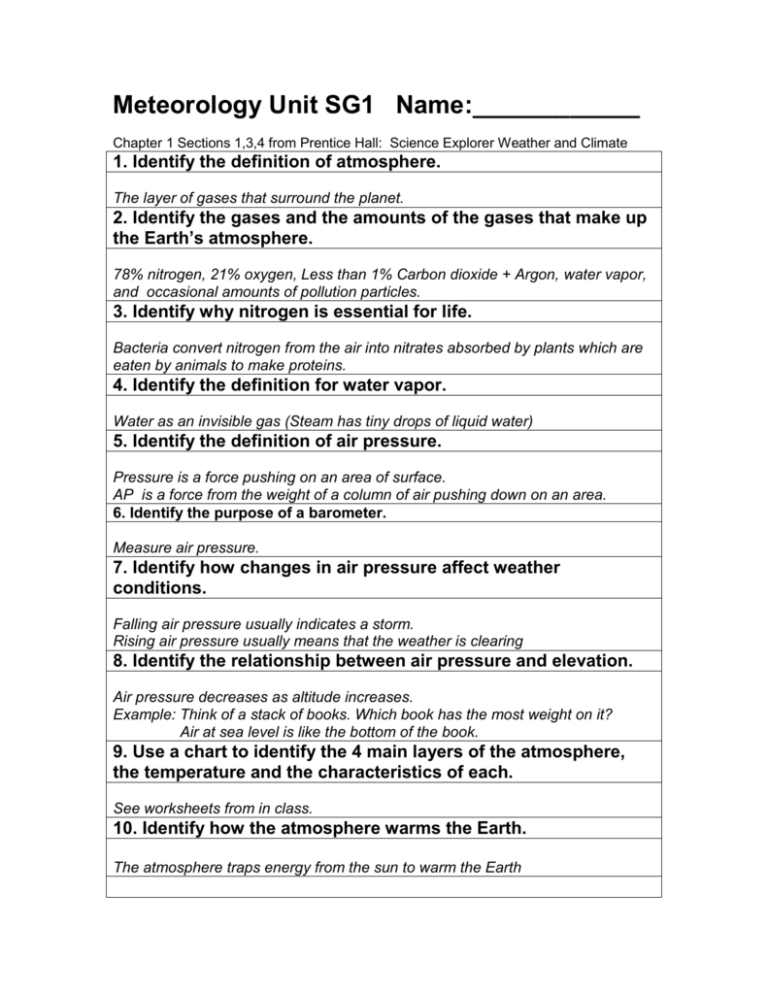
Meteorology Unit SG1 Name:____________ Chapter 1 Sections 1,3,4 from Prentice Hall: Science Explorer Weather and Climate 1. Identify the definition of atmosphere. The layer of gases that surround the planet. 2. Identify the gases and the amounts of the gases that make up the Earth’s atmosphere. 78% nitrogen, 21% oxygen, Less than 1% Carbon dioxide + Argon, water vapor, and occasional amounts of pollution particles. 3. Identify why nitrogen is essential for life. Bacteria convert nitrogen from the air into nitrates absorbed by plants which are eaten by animals to make proteins. 4. Identify the definition for water vapor. Water as an invisible gas (Steam has tiny drops of liquid water) 5. Identify the definition of air pressure. Pressure is a force pushing on an area of surface. AP is a force from the weight of a column of air pushing down on an area. 6. Identify the purpose of a barometer. Measure air pressure. 7. Identify how changes in air pressure affect weather conditions. Falling air pressure usually indicates a storm. Rising air pressure usually means that the weather is clearing 8. Identify the relationship between air pressure and elevation. Air pressure decreases as altitude increases. Example: Think of a stack of books. Which book has the most weight on it? Air at sea level is like the bottom of the book. 9. Use a chart to identify the 4 main layers of the atmosphere, the temperature and the characteristics of each. See worksheets from in class. 10. Identify how the atmosphere warms the Earth. The atmosphere traps energy from the sun to warm the Earth 9. identify the definition of electromagnetic waves. Energy from the sun that can travel through space. Detail: Electromagnetic waves are classified according to wavelngth or the distance between waves. 10. identify the forms of sun’s energy that reaches the Earth. Visible Light – mixture of all of the colors that you see (ROYGBIV) Infrared radiation – longer wavelengths than visible light. Not see but felt as heat. Ultraviolet radiation – wavelengths shorter than visible light. 11. identify what happens to the Sun’s energy on Earth. a. some is reflected (bounced) b. some is absorbed (soaked in) 12. identify the definition of temperature. Gases are made up of atoms that are constantly moving. The faster the molecules, the more energy they have. Temperautre is the average amount of energy produced by these atoms. 13. identiy the scales used to measure temperature and the boiling point and freezing point of each. 13. Fahrenheit scale – freezing water is 32 degrees, boiling water is 212 degrees Celsius scale – freezing water is 0 degrees, boiling water is 100 degrees 14. identify the 3 means by which heat is transferred Give an example of each. Radiation: direct transfer of energy by electromagnetic waves. EX: Sun tan/burn Conduction: Direct transfer of heat from one object to another object. EX: touching a hot stove. Convection: Transfer of heat by the movement of air or water. EX: Drying your wet shoes at the vent although the furnace is in the other room. 15, sequence the process of convection currents. 1) When the air near the ground is heated, the molecules have more energy and move faster. 2) As the atoms move they bump into each other and move farther apart, so the air becomes less dense. 3) Cooler denser air sinks forcing the warmer less desne air to rise. 4) The sinking + rising cycle continues 16. identify the definition and the cause of wind. 16. Wind is the movement of air from an area of high pressure to an area of lower pressure. All winds are caused by differences in air pressure which is caused by unequal heating of the Earth’s surface. 17. identify an explanation about why the sky is blue. Dust particles and gasses in the atmosphere reflect light from the sun in all directions. Scatterlight is bluer than ordinary sunlight, which is why the daytime sky looks blue. During sunrise and sunset, when sunlight passes through a greater thickness of atmosphere, scattering removed more blue light and causes the sun to look red. 18 18 19. identify the definition of water vapor. Water vapor is water in the form of a gas. It’s invisible. The amount of water vapor varies in the air varies. Clouds form when water vapor condenses. 20. identify the definition of humidity. Humidity is the amount of water vapor in the air. 21. identify the effects of relative humidity. Sweat removes heat from your body and the evaporation of sweat helps to cool you. When the relative humidity is high, evaporation slows down and you cool off less. 22. identify the definition of condensation. The process by which atoms of water vapor (gas) in the air become liquid water is called condensation. Examples: dew and frost (frozen dew) 23 Identify the process by which clouds form. Water vapor (gas) condenses to form clouds when warm air rises. 24.Identify different types of clouds based on a given diagram. See an in class worksheet. 25. Identify the process by which clouds produce precipitation. When cloud droplets grow by colliding and combining with other cloud droplets. As they grow larger they fall faster and collect more and more small droplets. Finally the droplets become heavy enough to fall out of the cloud as rain drops. 26. identify the definition of air mass. It is a huge body of air that has similar temperature and humidity. Air masses formed over water are more humid than those formed over land. 27. Identify the process by which air masses move. The prevailing westerlies push air mass in the US from west to east. 28. identify the cause of a front. 28. Air masses sometimes bump into each other. If they have different temperatures and densities, they do not mix and that area becomes a front. The collisions of air masses often causes storms and changeable weather. 29. identify the differences between 3 weather fronts, and how each affects the weather. Cold front forms when cold air moves underneath warm up forcing the warm air to rise. Brings cold, dry air to the area. Warm front forms when warm air moves over cold air. Brings warm, humid air. Stationary front forms when cold and warm air masses meet but neither has enough force to move the other. It may bring many days of clouds and precipitation. 30. answer questions by looking at a weather map. See the in-class practice worksheets. 31. Identify how thunderstorms form. When warm, humid air rises is forced upward by a cold front, it cools forming tall storm clouds. Thunderstorms produce strong upward and downward winds inside of clouds. 19. Students will be able to identify the definition of jet stream. 20. Students will be able to identify the definition of El Nino ad the effects it has upon the US weather. 18. Students will be able to identify the science explanation behind “old folk tales” about the weather. When chair squeak, it’s about rain they speak. Cold is the night when the stars shine bright Explained: There are no clouds in the sky to act as a blanket and trap the Earth’s heat. Halo round the moon, rain or snow is coming soon. Students will be able to identify the definition of water vapor. Water vapor is water in the form of a gase. It’s invisible. The amot of water vapor varies in the air varies. Clouds form when water vapor condenses. Ch1: The atmosphere – Air, Air Pressure, Layers of Atmosphere Experiment: Particulate Matter and Pollution (Vacuums, Filters?) Experiment: Weight the empty and air filled balloon. Video: Fearless Felix ??? Ch2: Weather Factors – Energy in Atm, Winds, Water, precip Ch3: Weather Patterns – Air Masses and Fronts, storms, prediction 15. identify difference between rain, sleet, freezing rain, snow. Sleet forms when raindrops fall through a layer of freezing air and turn into solid ice particles. Freezing rain forms when liquid raindrops freeze on a cold surface + can form a thick layer of ice. Snow forms when water vapor in a cloud is changed into ice crystals. 17. explain the process of air movement between the equator and the poles. Warm air rises at the equator, and sinks at the poles. Air pressure is lower near the equator and greater neart the poles. At the Earth’s surface the winds blow from the poles toward the equator. The Higher in the atmosphere, the air flows away from the equator toward the poles. 18. identify the Coriolis Effect. As the winds from the poles move, the Earth rotates from west to east making it seem as if the winds have curved. 27. Identify the conditions that cause fog. Fog is a cloud on the ground. It often forms when the ground cools at night after a warm, humid day. 1. Identify how the atmosphere makes conditions on Earth suitable A, The atmosphere traps energy from the sun to warm the Earth (absorbs) B. It protects living things from dangerous radiation from the sun. (reflects) C. It prevents the Earth’s surface from being hit by most meteroids (chunks of rocks from outerspace) 4, identify the definition of density. Density is the amount of mass in a parrticular volume. If there are more molecules in a certain volume, the density is greater. If there are fewer molecules in a certain volume, the density is less. Example: Think of a packed suitcase (very dense) compared to a less packed suitcase (less desne) 3. identify the properties of air (as a gas) Because air is made of atoms, it has density and pressure. 5. Identify the definition of pressure and it’s relationship to density. Pressure is the amount of force pushing on an area or surface. A dense substance has more mass so dense air exerts more pressure. A less dense substance has less mass, so it provides less air pressure. Example: Think of a heavy backpack loaded with books. The weight presses the straps into your shoulder.
